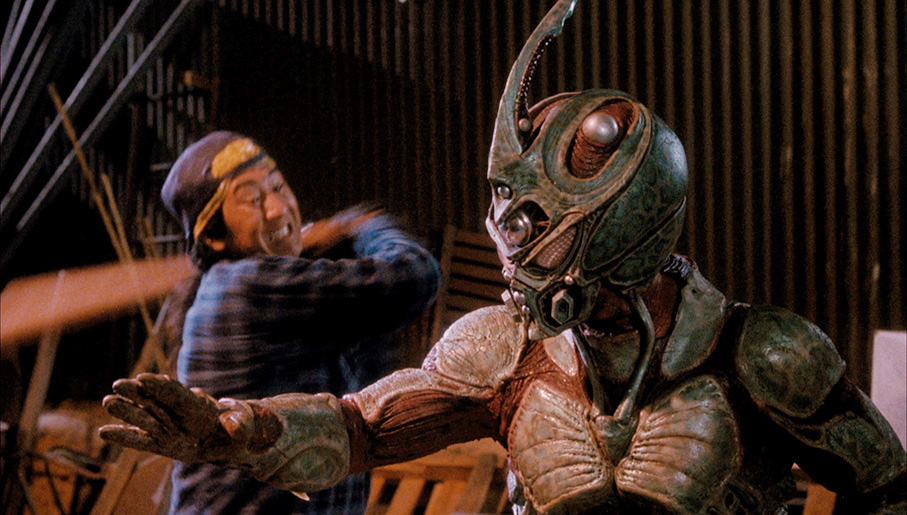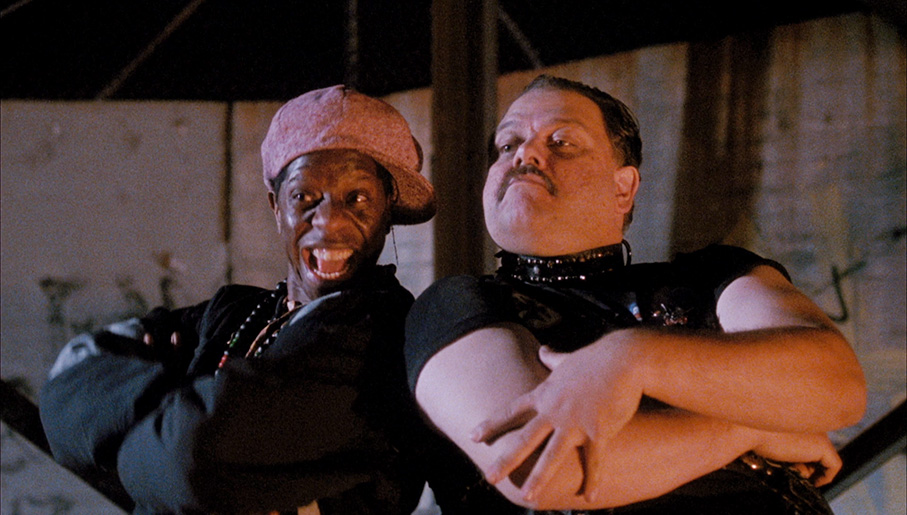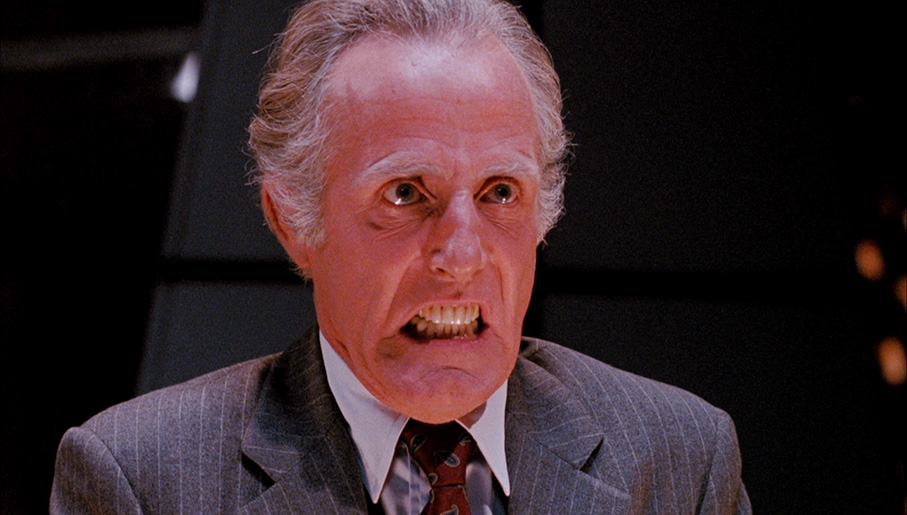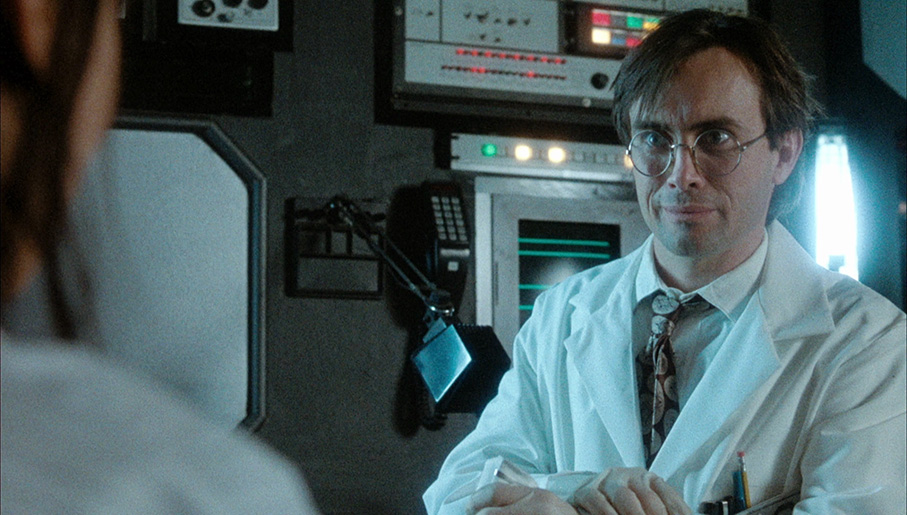|
What, you may ask, is a Guyver? Good bloody question. If you're a fan of the original Japanese manga or the animated series that it spawned, then you'll already know. If that includes you, then I'm guessing you're the target audience for this daffy cinematic peculiarity. If, on the other hand, you've never even heard of The Guyver, you may well be left as open-mouthed as I was by what unfolds here.
Humankind, we are informed by the opening text scroll and the theatrically-voiced buffoon who kindly reads it out for sight-impaired viewers, is actually the "ultimate organic weapon" created by aliens at "the beginning of time." Really? The beginning of time? Then where did these aliens come from in the first place? A place outside of time? The future? OK, figure of speech, we'll let that one pass. What we do know is that these aliens planted a special gene into man that enables individuals to turn into humanoid lizards, or "super monster soldiers" as the text would have it. Presumably after aeons of sleep, the Zoanoid leader – who is creatively referred to here as the Zoalord – has awakened and has founded the Chronos Corporation to develop the Zoanoid technology for the purpose of eventual world domination. Oh no. One piece of alien technology that they have uncovered is a device that some witless twerp has named "The Unit" (someone really needs to speak to their marketing department), a bio-boosted alien armour that if worn by humans increases their natural powers "a hundred-fold." I've quoted that directly for recall later when I get on to how these powers manifest themselves. Anyway, when wearing this armour, the human in question becomes The Guyver. The only problem is that, despite having seemingly limitless wealth and an army of scientists at their disposal, no-one at Chronos can work out how to switch The Unit on. All clear?

As regular visitors to the site may have noticed, I've something of a soft spot for low-budget horror flicks saddled with cheesy dialogue and iffy performances. I'm altogether less enthusiastic for films that deliberately embrace these production values because the makers think it's cute or amusingly kitsch, and I'm genuinely not sure of which side of that fence The Guyver sits on. The tone is set by the opening scene. Tetsu Sagawa, a research scientist for the Chronos Corporation, has had a conscience attack about what the firm is doing and has stolen The Unit to pass on to moustachioed CIA operative Max Reed, who's been investigating the company's nefarious activities. Handily for those who couldn't be bothered to read the opening text, Sagawa is still wearing his lab coat as he flees. That way we know he's a scientist from the moment we see him, but it also allows his pursuers to spot him more readily as he runs through the night. Ah yes, his pursuers. A hopeless bunch of comically cartoonish reprobates, they're led by the lanky and black-swathed Lisker, who's played by genre favourite Michael Berryman. This should be the film's first fanboy high-five, but despite his imposing screen presence, Berryman here trades largely on angry stares and threats delivered slowly by adding small pauses between each...of...the...words. But Sagawa is no ordinary scientist, and when threatened by Lisker he mutates into a Zoanoid. Lisker then does likewise and a brief, you-fight-like-a-girl punch-up concludes when Lisker crushes Sagawa's head into a pulp. What these idiots fail to realise until too late is that that Sagawa has stashed The Unit elsewhere and the case he was carrying is actually empty. Boy, are they in trouble now.
We're then introduced to our leading man, Sean Barker, as he fails to pay attention during his aikido class and gets knocked on his arse by an intolerant instructor. Distraction then arrives in the shape of his oriental girlfriend Mizky, who it turns out is professor Sagawa's daughter. We learn this when she is approached by Max Reed, who rolls in to inform her of her father's death. Sean, who's watching her distressed reaction through a handily placed window instead of paying attention in class, takes another pounding, this time from one of his fellow students. A few seconds later, it happens again. Jeez, even my kung-fu is better than Sean's kung-fu. Max drives Mizky to the storm drain where her father's body is being scooped up by the cops, and Sean discreetly gives chase on his scooter. In the process of spying on the pair from a distance, he stumbles across the case in which The Unit is hidden and – as you would – he stuffs the device in his backpack.

A short while later, Sean is ambushed by a street gang, who kick his scooter over and smack him around, which prompts him to fall face-first onto The Unit. This, it turns out, is how you switch it on, and the device promptly expands and wraps itself around Sean and turns him into a metallic Power Ranger. As you would expect, he is now able to deliver the gang the sort of beating they deserve, but nothing he does even hints that his natural powers have increased "a hundred-fold" as claimed by the opening text. I'm estimating three-fold at best, and even then he seems to struggle to escape when being grabbed by one of the gang from behind. Once the fight has concluded, the armour unwraps and recedes into Sean's body through two small holes on the back of his neck.
Meanwhile, over at the Chronos Corporation, Lisker takes some serious telepathic punishment from corporate head honcho and Zoalord in human form, Fulton Balcus, for failing to retrieve The Unit as ordered. Given a second chance to carry out his set task, Lisker and his goons try to kidnap Mizky, another bungled operation that has the effect of teaming Sean up with Max, whose subsequent pursuit of the gang puts their lives in peril and pits the newly empowered Sean against Lisker and the all-powerful Balcus.
The Guyver was directed by the colourful pairing of Steve Wang and Screaming Mad George, both of whom first made their names in the world of physical make-up effects, Wang on the likes of Predator, The Monster Squad and DeepStar Six, while Screaming Mad George (who also worked on Predator) is still fondly remembered for his work on the gloriously mad climax of cult favourite Society. It's thus no surprise that the makeup and effects work is top-notch here, and it's clear that this was Wang and George's comfort zone. I'm guessing that characterisation and performance direction were not.

Let's start with Lisker's motely band of goons. Yes, I know this all began life as a manga, but why, if the Zoanoid gene is in all humananity, would the black ops arm of a powerful conglomerate employ a gang comprised entirely of cartoon street thugs – including an ever-grinning and (badly) rapping black dude, an overweight white punk and an angry, gum-chewing, leather-clad female – to do their dirty work instead of hiring ex-soldiers who are trained in this stuff? I'm sure we're meant to find them funny, but I winced every time the dreadful bastards appeared, and when these guys mutate into Zoanoid form, they transform into human-sized and mutated Gremlins. A convincing threat they most definitely are not.
More than one contemporary review of the film highlighted the lack of charisma of wonderfully named leading man Jack Armstrong, and while I'm not about to argue, he at least appears to believe in what he's doing. Witnessing Vivian Wu act all distressed as Mizky, on the other hand, made me wonder if the directors were even watching the actors do their stuff (and Wu has proved her worth elsewhere many times). That said, even she feels like a paragon of subtlety next to David Gale's barnstorming, eye-bulge of a turn as Fulton Balcus. Only Mark Hamill makes it through with his reputation intact as Agent Max Reed, though even he has a couple of hesitant moments that an actor's director would likely have polished up.

The plot is by the comic-book supervillain numbers, and while watching Gremlins do battle with a metal Power Ranger is amusing for a while, the fights themselves just aren't inventive or dangerous enough to sustain the screen time that they swallow (they are effectively guys in rubber suits repeatedly hitting each other, livened up with the occasional martial arts move, which is how it comes across). Much of the humour feels forced and only a couple of steps from having the characters turn and wink at the camera, but nestled in there are a couple of unexpected gems. In the first, grinny rap-master Striker transforms into a Gremlin (sorry, a Zoanoid) and leaps over a fence to be confronted by a woman and the longest, most ear-piercing scream I've ever heard in a movie, which he responds to by nervously encouraging her to cease. It turns out he's landed in the middle of a horror film shoot and has been mistaken for the production's own cheapjack monster. But what really sells the gag is when the production's director appears and starts pep-talking Striker about how he should play the scene, and instead of tearing him asunder, Striker listens earnestly and appears to be taking on board what he is saying, ignoring his mission and psyching himself up for a second take instead. Later, there's a nicely handled in-joke targeted purely at genre fans, when Balcus consults two of his scientists, one of whom is named Doctor East and is played by cult favourite Jeffrey Combs in a straight-up reprisal of his career-defining role as Doctor Herbert West in the Re-Animator films. The gag is enhanced by the presence of David Gale, who played West's rival Dr. Carl Hill in the original Re-Animator, and the fact that both that film and this one were produced by Brian Yuzna, whose own directorial debut, Society, was the film that put the name of Screaming Mad George on the horror makeup map.
Oh, I don't know. If this is your bag then I have to admit that it's harmless enough fun, though I was not too surprised when no-one I spoke to about the film seemed to have heard of it, or that it didn't exactly set the box-office alight on its release. If you came for the script and the performances then I'd keep your coat and hat on, as you won't be staying long, but if you're only tuning in for the creatures and the sort of yuckier makeup effects for which Screaming Mad George is justifiably celebrated, then you'll find plenty to chew on in the film's second half. It's certainly pacey (though don't get me started on the music score), and I've no doubt fans of the manga or the animated series will be in pig heaven here. As for me, well I've recently been trying to improve my diet, which unfortunately involves having to cut down on the cheese.
An impressive 1.78:1 transfer with punchy contrast, a deliberately cool though still sometimes lively colour palette, and a consistently crisp level of detail. A few of the highlights feel a little hot, but this may be how the film was lit in the first place, and there's no softening of contrast or swallowing of shadow detail in the many night scenes. Film grain is minimal and there's hardly a dust spot to be seen throughout the film. The comic-book look is very well served here.

You can choose between Linear PCM 2.0 stereo or go the full hog with DTS-HD Master Audio 5.1 surround, which is far and away the more inclusive of the two. Both have a decent dynamic range and excellent clarity, but the surround track has more punch and makes strong use of all speakers for the music and effects.
Optional English subtitles for the deaf and hearing impaired are on board as expected.
Brian Yuzna Interview (8:50)
Producer Brian Yuzna is interviewed by Mark Alan Miller, vice-president of Clive Barker's Seraphim Incorporated and a big fan of the film. Given its short running time, it's no surprise that they stick to the essentials here, focussing on how the project came to be, the casting, post-production and marketing. The Pringles box style press kit they devised to hand out to the press is really neat, and doubtless a killer collectable now. Apparently Yuzna was convinced the film would be a huge hit. I'm saying nothing. The Commodore Amiga graphics program-style opening title brought back some memories.

There are three rolling Image Galleries: Behind the Scenes (2:55), Figurines (1:07), and Artwork (3:55), which includes international posters and VHS video cases, including some under the film's European release title of Mutronics.
US Trailer (0:25)
More a teaser consisting of a single extract from the film when Sean turns into The Guyver under his own volition.
German Trailer (2:33)
Complete with the European Mutronics title, some harsh German dubbing and a voice-over that sounds like one you'd find on a documentary about the end of the world, this is at least more of a trailer than the US one above, though does include the result of the climactic battle and the last shot of the film, goddammit.
The first pressing also includes a fully-illustrated collector's booklet featuring new writing on the film, but we've not seen that.
I can't say I got that much out of The Guyver beyond its impressive makeup effects and a couple of priceless comedy moments. It'll doubtless work for some, and if you're already a fan then you'll have no complaints about the HD transfer here, though you might feel a little short-changed by the extras, which are seriously light compared to the Arrow Video norm.
|